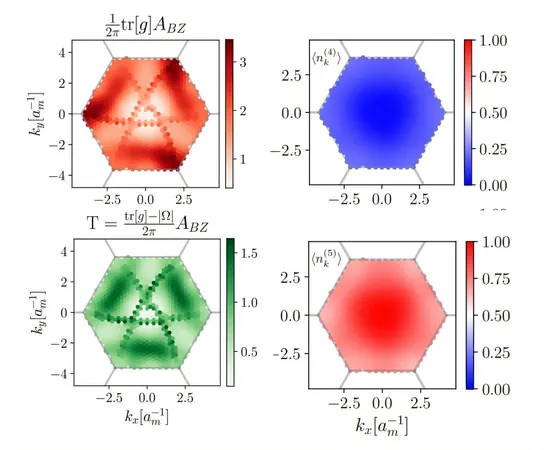
Unveiling the Mystery of Fractional Charge in Pentalayer Graphene – A Breakthrough by MIT Physicists!
2024-11-19
Author: Olivia
Introduction
In an exciting development for the world of condensed matter physics, researchers at MIT have made significant strides toward understanding how electrons in pentalayer graphene can behave as if they possess fractional charges. This groundbreaking research could reshape our understanding of electronic states in two-dimensional materials.
Background Discovery
Earlier this year, Assistant Professor Long Ju and his team made headlines by demonstrating that, under certain conditions, electrons in a unique structure of five graphene layers—known as pentalayer graphene—appear to divide into fractions of their total charge. Astonishingly, this phenomenon occurs even in the absence of a magnetic field, breaking longstanding assumptions about the conditions required for such fractional behavior.
Historical Context
Historically, fractional charge phenomena, such as the fractional quantum Hall effect, have only been observed under exceedingly high magnetic fields. The discovery of the fractional quantum anomalous Hall effect in pentalayer graphene challenges previous expectations and opens up a realm of possibilities for new experimental investigations.
Research Leadership and Findings
Leading the latest study to uncover the underpinning mechanisms of this phenomenon is Professor Senthil Todadri, who utilized advanced quantum mechanical calculations to show that the electrons in pentalayer graphene arrange themselves in a unique crystal structure. This configuration is highly conducive to the emergence of fractional electron states. "This is a completely new mechanism," says Todadri. "For decades, researchers have not seen a system give rise to these types of fractional electron behaviors. It ignites the potential for numerous experimental pursuits that were previously considered unattainable."
Collaboration and Recognition
Published in Physical Review Letters, the paper also acknowledges similar findings from other leading research groups, including teams from Johns Hopkins University and a collaboration involving Harvard University and UC Berkeley, all contributing to an enriching discourse on this intriguing topic.
Prior Breakthroughs in Graphene Research
The concept of fractional electron phenomena was initially explored through a revolutionary discovery in 2018 when MIT’s Pablo Jarillo-Herrero demonstrated that stacking and twisting two sheets of graphene could lead to exotic electronic behaviors. The angle of stacking created a moiré pattern, resulting in both superconducting and insulating attributes within the same material—an innovation that ignited a new field of study known as "twistronics."
Reassessment of Theoretical Approach
Todadri emphasizes the excitement surrounding the potential of these moiré systems to reveal the conditions under which fractional electron phases can materialize, saying, "We identified these as ideal systems to explore fractional phenomena." However, a recent conversation with Ju regarding his experimental discoveries led to an unexpected twist in understanding the role of quantum properties in pentalayer graphene.
Experimental Surprises
The researchers initially theorized that electrons would exhibit multiple twists in their wavefunctions as layers were added. To their surprise, Ju's experiments indicated a single twist instead, prompting a reassessment of their theoretical approach.
New Framework for Analysis
This led Todadri and his team to develop a new framework for analyzing electron interactions in pentalayer graphene. They discovered that, in two-dimensional systems, high-density electron interactions generate compelling quantum correlations. This creativity in electron behavior reveals a complex dance of repulsion and cooperation among electrons that solidifies their fractional charge properties.
Implications of the Study
The arrangement in pentalayer graphene establishes a weak electrical potential, causing electrons to form a structure akin to a crystal. Therefore, as electrons traverse this potential, they morph into a wavefunction—an interconnected cloud of potential states—for each electron that can interact with others, setting the stage for fractionalization that delights physicists eager for novel experimental ventures.
Future Research Directions
“This discovery provides a theoretical basis for enhancing our understanding of electron fractions in pentalayer graphene,” Todadri remarks. “Moreover, it prompts many fascinating questions for future research in similar systems.
Conclusion and Outlook
As this captivating field continues to unfold, the implications of fractional charge in pentalayer graphene may hold the key to innovative technologies in quantum computing and advanced materials science. Keep your eyes peeled for more revelations from this thrilling domain!









 Brasil (PT)
Brasil (PT)
 Canada (EN)
Canada (EN)
 Chile (ES)
Chile (ES)
 España (ES)
España (ES)
 France (FR)
France (FR)
 Hong Kong (EN)
Hong Kong (EN)
 Italia (IT)
Italia (IT)
 日本 (JA)
日本 (JA)
 Magyarország (HU)
Magyarország (HU)
 Norge (NO)
Norge (NO)
 Polska (PL)
Polska (PL)
 Schweiz (DE)
Schweiz (DE)
 Singapore (EN)
Singapore (EN)
 Sverige (SV)
Sverige (SV)
 Suomi (FI)
Suomi (FI)
 Türkiye (TR)
Türkiye (TR)